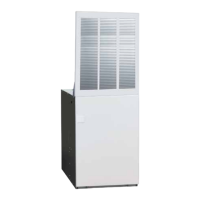3
IMPORTANT SAFETY INFORMATION
Safety markings are used to designate a degree or level
of seriousness and should not be ignored. WARNING
indicates a potentially hazardous situation that if not
avoided, could result in personal injury or death. CAUTION
indicates a potentially hazardous situation that if not
avoided, may result in minor or moderate injury or property
damage.
WARNING:
Improper service, adjustment or maintenance of
conditions which may result in personal injury,
property damage, or death. Installation or
trained personnel thoroughly familiar with this
WARNING:
materials (paint thinners, etc.) in the vicinity of
this appliance. Failure to comply may cause fire,
may result in serious injury, death or property
damage.
The following list of chemicals should not be used or
stored near the furnace:
• Chlorinatedcleaners
• Watersofteningchemicals
• De-icingsaltsorchemicals
• HouseholdCleaningSolutions
• Printinginks,paintremovers,varnishes,etc.
• Cementsandglues
• Antistaticfabricsofteners
WARNING:
water. A flood damaged furnace is extremely
dangerous. Attempts to use the furnace can result
to replace any electrical or control system parts
OPERATING INSTRUCTIONS
NOTE: Thermostat styles vary. Some models may not
include the AUTO mode and others will have the AUTO
in place of the HEAT and COOL. Others may include all
three. Please refer to the thermostat manufacturer’s User
manual for detailed programming instructions.
NOTE: Allow at least one hour for the room temperature
to stabilize before you make a second adjustment to
the thermostat setting. After the desired comfort level is
established, make only small adjustments to the thermostat
setting to meet changing temperature conditions.
Cooling Operation
1. Set the thermostat’s system mode to COOL or AUTO
and change the fan mode to AUTO. See Figure 1 (page
4).
2. Set the temperature selector to the desired temperature
level. The outdoor fan, compressor, and blower motor will
all cycle on and off to maintain the indoor temperature
at the desired cooling level.
Heating Operation
1. Set the thermostat’s system mode to HEAT or AUTO
and change the fan mode to AUTO. See Figure 1.
2. Set the temperature selector to the desired temperature
level. The compressor, outdoor fan, and blower motor
will cycle on and off to maintain the indoor temperature
at the desired heating level.
The continuous indoor blower operation is typically used to
circulate the indoor air to equalize a temperature unbalance
due to a sun load, cooking, or fireplace operation.
Set the thermostat fan mode to ON (Figure 1). The indoor
blower starts immediately, and will run continually until
the fan mode is reset to AUTO.
The continuous indoor blower operation can be obtained
with the thermostat system mode set in any position,
including OFF.
Turning the Heater OFF
Change the thermostat’s system mode to OFF and the fan
mode to AUTO. See Figure 1. NOTE: The system will not
operate, regardless of the temperature selector setting.
CAUTION:
For optional A/C or H/P systems, always wait
at least five minutes after the system shuts off
USER INFORMATION

